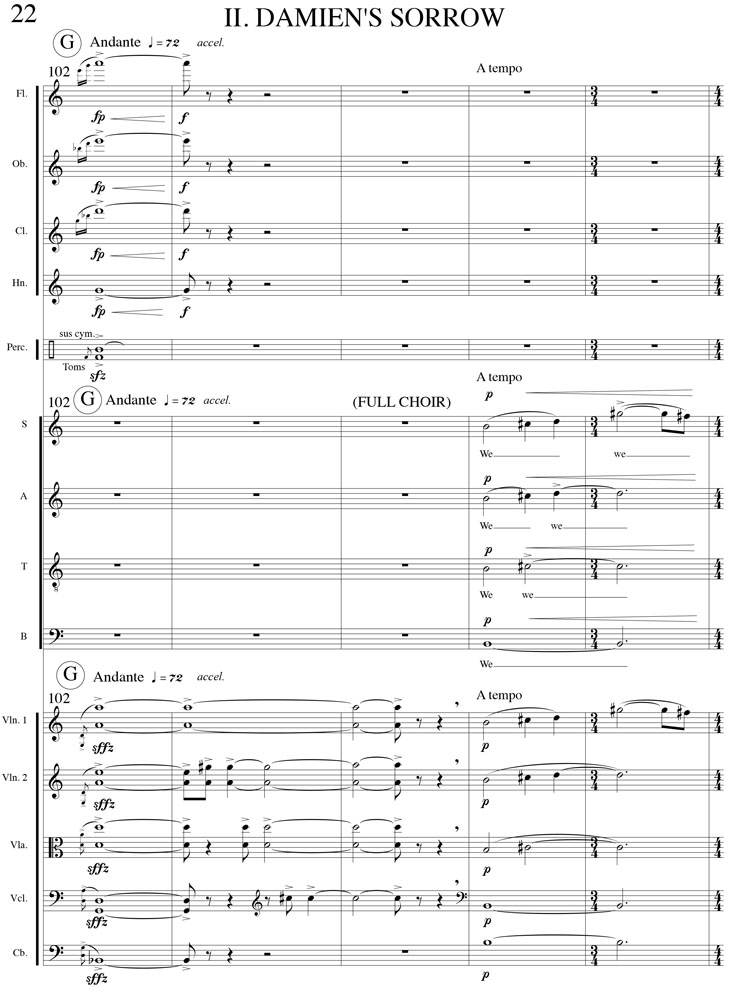Voices of Kalaupapa
Price range: $20.00 through $450.00
choir & chamber orchestra
(fl, ob, cl, hn, 1 prc, strings)
Prelude: Miserere
I. Damien’s Grace
II. Damien’s Sorrow
Interlude: Lacrimosa
III. Damien’s Joy
Interlude: Requiem Aeternam
Postlude: Lux Aeterna
25:00
2009
Voices of Kalaupapa was commissioned by the O‘ahu Choral Society to celebrate the life and work of Saint Damien de Veuster, whose work at Kalaupapa – or, more accurately, Kalawao, the side of the Moloka‘i peninsula where the settlement housing those afflicted with Hansen’s disease and exiled from the outer world was first located – was one of the great models of caring and kindness in human history. Damien came to Hawai‘i from Belgium in 1864 to perform missionary work, and after serving two posts on the Big Island for nine years, volunteered to go to Kalaupapa, where he ministered to those who had been banished to the Moloka‘i leper colony, as it was called at the time. Eventually, he contracted the disease himself, and died in 1889 at the age of 49, already world-renowned for his efforts to help the sick and disenfranchised. Damien was canonized by Pope Benedict XVI on October 11, 2009.
Voices of Kalaupapa is divided into seven movements – three main movements with a prelude, two interludes, and a postlude – all of which are performed without pause. The piece does not follow a story in the strict sense, but instead reflects on various aspects of Damien’s experience at Kalaupapa, his deep spirituality, his eagerness to give of himself in serving others, his trials and suffering, and the intense satisfaction that the generosity of his work created in him.
The text for the piece was taken from the Hawaiian language translation of the bible, Baibala Hemolele, from the Latin Mass, and from quotes of Damien himself, which were freely adapted by the composer. Each language represents a different perspective. The English language text is set as if spoken by Damien, while the three biblical quotes in Hawaiian are set as if spoken by witnesses to Damien’s acts of kindness. The Latin text is set from the point of view of an outside observer, perhaps one whose perspective is more timeless.
At Kalaupapa, instead of addressing his congregation with the traditional “my brothers”, Damien employed the phrase “we lepers”, long before he himself contracted Hansen’s disease. This simple act of solidarity signifies perhaps his greatest contribution to the settlement, the total gift of himself. In a broader sense, this phrase, which recurs throughout each of the main movements of the piece, symbolizes the greatest potential of mankind, and carries connotations that are both bitter and triumphant, as revealed by the differing character of the music that accompanies it in each movement.
The piece begins with a spoken biblical quote in Hawaiian, followed by a short prelude, Miserere Nobis. Overlapping vocal lines slowly unfold downward to create an air of meditation, while the intonation of the Latin text suggests the spirituality of a mass.
Damien’s Grace reflects his selflessness, his willingness to serve others, and his acceptance that man is destined to suffer in this world, with the faith that a greater existence lies beyond this life. After an invocation of “we lepers” – addressing not only his congregation, but all of us – a recitative passage describes his love of charity. A faster section follows and speaks of his work as a spiritual guide. After a small climax and a colorful mysterious passage the phrase “we lepers” returns with a more dramatically intense character to end the movement.
Another spoken biblical quote in Hawaiian serves as a transition to the second main movement, Damien’s Sorrow, in which his worldly trials are brought forth. This dramatic movement is the most dissonant of the piece, drawing on thick textures of sound that suggest the pain of watching those around him suffer greatly. Passages of anguish are contrasted by moments of tenderness, reflecting the kindness Damien brought to coexist with such terrible grief.
A short interlude, Lacrimosa, follows, sung a cappella by chamber choir. The simplicity of the music creates an almost mystical feel and offsets the mournful text, which asks for mercy on the fateful day of judgment to come.
Damien’s Joy abruptly interjects a state of intense happiness. This brief, near-ecstatic movement draws on Damien’s discovery that his greatest fulfillment came in completely emptying himself to give his all to others. The last line of text, “I am the happiest missionary in the world”, which he wrote in a letter to his brother shortly before his own death, is suddenly interrupted, much like his life.
A second a cappella interlude, Requiem Aeternam, follows, asking that eternal rest be bestowed upon those who have passed from this earth. Chamber choir is again used to create a sense of intimacy – of being inside one’s own mind – in this pensive movement.
The postlude, Lux Aeterna, begins with a passage for orchestra, with choir gradually joining to intone the text in a chantlike manner. Mirroring the opening movement, line after line unfolds upward in seemingly eternal fashion as the music builds to a joyous yet solemn climax. As the choir slowly drops away, the music continues gently upward, ever softer and higher, suggesting the passing of a soul toward the eternal light…

